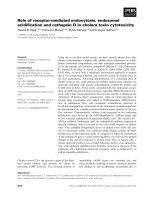Characterization of zebrafish vitellogenin gene family for potential development of receptor mediated gene transfer method 5
Bạn đang xem bản rút gọn của tài liệu. Xem và tải ngay bản đầy đủ của tài liệu tại đây (87.9 KB, 4 trang )
Chapter 5. General conclusions
Chapter 5.
General conclusions
184
Chapter 5. General conclusions
Based on the findings presented in this thesis, the following general conclusions can be
drawn:
1) At least seven distinct vitellogenin genes (vtgs) were found in the zebrafish (Danio
rerio) genome and they fall into three groups: A (vtg1 and vtg4-7), B (vtg2) and C (vtg3).
Vtgs encoded by genes of groups A and C do not have the homologous subdomains IV
and V; while Vtg2 (group B) has subdomains IV and V. vtg3 was found to encode a Vtg
also without the phosvitin domain and may represent a primitive vtg in vertebrate genome.
No new vtg sequence was identified from the current zebrafish genome sequence database
(86% completion), indicating that there should not be substantially more vtg genes in the
zebrafish genome.
2) vtg3 was mapped to chromosome 11 whereas the other five vtgs (vtg1, vtg2, vtg4, vtg5
and vtg7) were mapped to chromosome 22 which likely harbors the vtg6 as well.
Phylogenetic analysis and genome mapping indicated that the lineage specific
amplification of group A vtgs may occur through tandem duplication of a vtg1-like
precursor gene while the vtg precursors leading to the divergence of vtg3 and the other vtg
genes might arise from chromosome or whole genome duplication certainly before the
radiation of the teleost fish.
3) Expression and quantification studies indicated that in addition to the female liver, vtg
mRNAs were also present in several non-liver tissues, including the intestine, ovary,
muscle and skin in female fish, and the intestine, testis, muscle, skin and gill in E
2
treated
male fish. In extra-hepatic tissues examined, the expressions of vtgs were localized mostly
in adipocytes. Interestingly, enlarged vascular termini composing mainly of special
185
Chapter 5. General conclusions
adipocytes were identified in the ovary and strong vtg expression was detected in these
special adipocytes. In the extra-hepatic vtg expressing sites, transcripts of vtg1 and vtg2
were detected; whereas vtg3 mRNAs were barely detectable by in-situ hybridization.
4) In the liver of control female fish, the expression levels of vtg1-3 mRNAs differed, with
the strongest expression in vtg1, followed by vtg2 and vtg3, which probably indicates
different transcriptional activities of the three vtg genes in zebrafish. Similar trends were
also observed in other vtg-expressing tissues.
5) Northern blot analysis showed that the expressions of all seven vtg genes were
enhanced in female fish or induced in male fish after E
2
treatment. Different folds of
increase in the expression levels of vtg1-3 were observed in different tissues of female fish
after E
2
treatment. In male fish after E
2
treatment, the expression levels of vtg1-3 were
found to be equal to or even higher than those in corresponding tissues in the control
female fish.
6) Red tilapia (Oreochromis mossambica) was used to explore the potential of using Vtgs
as DNA carriers for development of a novel method for producing transgenic fish.
Preliminary experiments showed that although the purified tilapia Vtg was predominantly
taken up by vitellogenic oocytes, the N-succinimidyl 3-(2-pyridyldithio)-propionate
(SPDP) modified Vtg moiety in Vtg-polylysine conjugates could not efficiently mediate
DNA uptake by oocytes. The reason may be due to degradation or denaturation of Vtgs,
destruction of receptor-binding capacity by SPDP modification or improper charge ratio of
DNA to Vtg-polylysine in the complexes.
186
Chapter 5. General conclusions
7) As an alternative approach, recombinant Vtg fragments were expressed and shown to
have a potential as DNA carriers. To localize the receptor-binding domain in these
fragments, seven 6xHis-tagged recombinant tilapia Vtg fragments were expressed in E.
coli and four of them were labeled with
32
P and used in the in vivo assay Results
indicated that none of these Vtg fragments could be taken up by oocytes specifically,
which may be due to the lack of proper posttranslational modification, insufficient zinc,
calcium or lipid contents of these Vtg fragments when they were expressed in a
procaryotic expression system.
In summary, the heterogenicity of vtg gene family and expressions of multiple vtg genes
were investigated using a model fish, the zebrafish (Danio rerio). The study of vtg genes
provides valuable information for further characterizing the zebrafish vtg family, such as
correlating the expression levels or E
2
inducibilities of different vtg genes with their
promoter elements and/or other trans-acting factors. Results from our systematic
investigation of the expression sites of vtg genes challenge the traditional belief that liver
is the only organ for Vtg synthesis in oviparous vertebrates. The preliminary studies on
receptor-mediated gene transfer using fish Vtgs as DNA carriers encourage future studies,
such as on how to improve the construction of conjugates and complexes.
187









